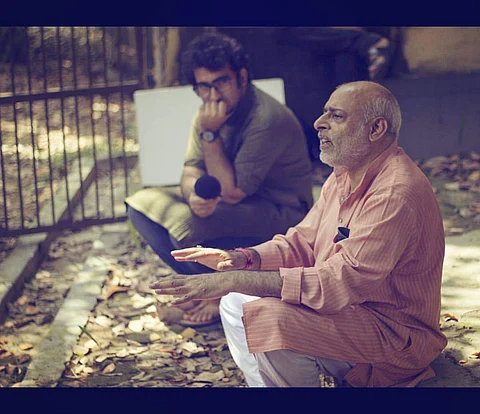

A few days ago, when Darpan Bajaj's documentary Maharajin was screened in Bengaluru, the audience seemed delighted with the story. This documentary is a hat tip to none other than late Gulab Tiwari, fondly known as Maharajin bua, the woman who went against religious norms to carry out the funeral rights of the deceased, which is a male-only domain as far as Hindu traditions are concerned. She decided to rise above gender discrimination to follow the tradition of her forefathers who worked on cremation grounds. She worked at the Rasoolabad Ghat in Allahabad for 60 years and legend has it that she saved those who used to visit the ghat to commit suicide. She passed away in 2002 and her son took over the baton.
This idea to shoot Maharajin's documentary came to Darpan when he was pursuing his Master’s in Design and Visual Communication from IIT Guwahati. He says, "We were told to work on a project in the final year. Since my interest was in making documentaries and short movies, I decided to go with it. It was not easy as it was the first time that I had taken on a project like this. But I was excited and searched for ideas with a positive message. Fortunately, one of my friends, Achintya Malviya told me about this woman who carried out cremation rituals for the dead in Allahabad. Initially, I thought I would research about her and narrate a fictional story. However, the story turned out to be unique and my team, Achintya, Arun Sharma and Moksh Krishnan and I, decided to bring it out in the form of a documentary."
If you watch Maharajin, you will be surprised to note that throughout the documentary there is no image or photo of Maharajin bua herself. When asked about the reason behind it, Darpan says, "We did not show her face or her old pictures because it is more about her work and we wanted the audience to form their own image of Maharajin rather than we forming it for them."
For the research, Darpan and his team spoke to poets, philosophers and historians who were originally from Allahabad and had seen her work every day. The documentary starts with a video of an Aghori Sadhu (a small group of Shiva worshippers) sharing his perspective on why women are forbidden from performing cremation of the deceased in Hinduism. He even speaks about the philosophy of life and death. Darpan says, "We shot this movie for five continuous days. While we had planned the rest of the shoots, the scene with the Aghori Sadhu was not planned. When my team and I were at Sangam in Allahabad, we came across the Aghori baba and asked him for his opinion."
Darpan also spoke to Harishchandra Pandey, a famous poet who has also written a poem on Maharajin. Their documentary ends with Harishchandra reciting this poem which is dedicated to her masculinity. "If he had not written the poem, then we would not have known her. Not just him, we interviewed a few others including Yash Malviya, a famous poet and historian, and writer Lal Bahadur Verma. The most interesting part of the documentary is Lal Bahadur Verma's interview and how he masterfully connects history, philosophy and Maharajin's struggle. Another point to not is that all of them pointed out that Maharajin would see death almost every day and yet, she accepted death as her friend," explains Darpan.
Like every other project that goes through several hurdles before it takes shape, Darpan's documentary also had to go through challenges. Their main concern was procuring equipment like camera and tripod which the institute did not provide. Darpan was able to get a small old recorder from one of his professors. A few professors even suggested that he make a movie on the river Brahmaputra instead and though Darpan found this a tad bit discouraging, he wasn’t disheartened.
The documentary was produced under the banner of Moksh Krishnan, who has worked in Bollywood movies as an Assistant Cinematographer and has his own production house called Dastan. "He was able to provide us with Canon EOS 5D Mark III, a tripod and lights. Some of the scenes have also been shot on my Canon EOS 550D and iPhone 6S. The scene of a guy performing Surya Namaskar and a boy jumping into the water are the two fillers which were shot on my iPhone. All the interviews were shot on Canon EOS 5D Mark III which adds a professional look to it. I even bought a Rode Shotgun Mic, but unfortunately, it did not work. We only realised this when Lal Bahadur Verma's interview went unrecorded. We then requested him to give the interview again and told him that we would like him to speak more on the subject because it was so interesting and he agreed! We used an old recorder, but I had to do a lot more to reduce the unnecessary sounds while editing."
From 2017 till date, the movie has been screened in several film festivals and has won many awards. The team won the Best Film Award in Gender category at the 5th Woodpecker International Film Festival 2017, Best Director Award at the 6th Smita Patil Documentary and Short Film Festival, Best Documentary Award at Feel The Reel International Film Festival and a few others. And we are sure that he will keep adding to the list of awards.
